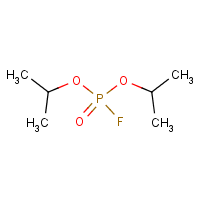Diisopropyl fluorophosphate
Agent Name
Diisopropyl fluorophosphate
Alternative Name
Isoflurophate
CAS Number
55-91-4
Formula
C6-H14-F-O3-P
Major Category
Pesticides

Synonyms
Isoflurophate; DFP; Diflupyl; Diflurophate; Diisopropoxyphosphoryl fluoride; Diisopropyl fluorophosphonate; Diisopropyl phosphofluoridate; Diisopropyl phosphorofluoridate; Diisopropylfluorfosfat [Czech]; Diisopropylfluorophosphate; Diisopropylfluorophosphoric acid ester; Diisopropylfluorphosphorsaeureester [German]; Diisopropylphosphorofluoridate; Dyflos; EA 1152; Floropryl; Fluophosphoric acid, diisopropyl ester; Fluorodiisopropyl phosphate; Fluorophosphoric acid, diisopropyl ester; Fluostigmine; Isofluorophate; Isoflurophosphate; Isopropyl fluophosphate; Isopropyl phosphorofluoridate; Neoglaucit; O,O'-Diisopropyl phosphoryl fluoride; O,O-Diisopropyl fluorophosphate; PF-3; Phosphorofluoridic acid, bis(1-methylethyl) ester; Phosphorofluoridic acid, diisopropyl ester; T-1703; TL 466; [ChemIDplus] UN3018
Category
Organophosphate Insecticides
Description
Clear colorless or slightly yellow liquid; [HSDB] Clear colorless liquid; [MSDSonline]
Sources/Uses
Used as insecticide, cholinergic for glaucoma treatment, and veterinary miotic; [HSDB]
Comments
Produces hydrogen fluoride on exposure to moisture; Extremely toxic cholinesterase inactivator; [Merck Index] Causes irritation and injury to skin and eyes; Vapor highly irritating to eyes and mucous membranes and causes miosis in trace amounts; Cholinesterase inhibitor that is highly toxic by skin absorption and inhalation; Symptoms of heavy exposure could include convulsions, cyanosis, pulmonary edema, and coma; [EPA OHM/TADS] Effects in high-dose animal studies include miosis, true cholinesterase inhibition, fasciculations, convulsions, and coma; [RTECS] “The average of two baseline respective cholinesterase activity determinations three days apart, with no exposures to enzyme inhibiting pesticides for at least 30 days, is recommended for each worker prior to exposure to cholinesterase inhibitors because of large inter-individual differences in published baseline values. To be established at least once a year. Removal from workplace exposures is recommended until the cholinesterase activity returns to within 20% of baseline.” [TLVs and BEIs]
Restricted
No longer registered as a pesticide for use in the US; [HSDB]
Biomedical References
Exposure Assessment
BEI
Acetylcholinesterase activity in red blood cells = 70% of individual's baseline; Butylcholinesterase activity in serum or plasma = 60% of individual's baseline; Sample at end of shift; [TLVs and BEIs]
Vapor Pressure
0.579 mm Hg
Lethal Concentration
LC50 (rat) = 360 mg/m3/10min
Explanatory Notes
The Guide in the Emergency Response Guidebook is for "Organophosphorus pesticide, liquid, toxic." VP from ChemIDplus;
Adverse Effects
Other Poison
Organophosphate
Diseases, Processes, and Activities Linked to This Agent
Diseases
Occupational diseases associated with exposure to this agent:
Processes
Industrial Processes with risk of exposure: